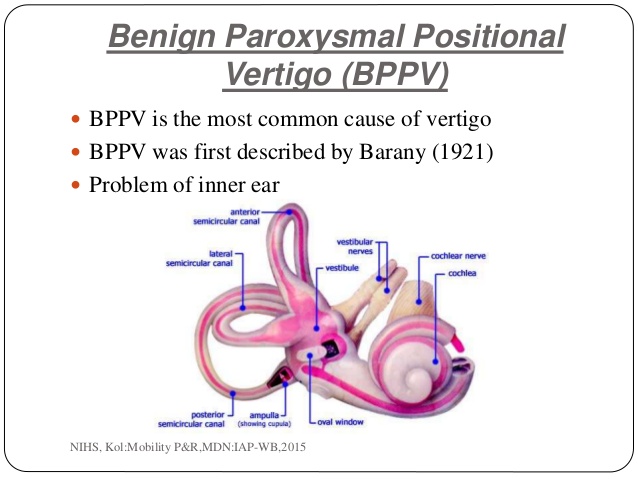Benign paroxysmal positional vertigo(BPPV)

Vestibular Systems
• Comprises five sensory organs that provide your brain with information about head position and movements including head rotation, linear movements and static positions of the head relative to gravity
• Five sensory organs including 3 semicircular canals and 2 otoliths
BPPV is a mechanical problem in the inner ear. It occurs when some of the crystals that are normally embaded in gel in the ear become dislodged. They then can move into one or more of the 3-fluid filled semicircular canals.
Benign paroxysmal positional vertigo(BPPV) is one of the most common causes of vertigo. It creates a false sensation of spinning.
• Benign: it is not life threatening
• Paroxysmal: it comes in sudden, brief spells
• Positional: it gets triggered by certain head positions or movements
• Vertigo: a false sensation of rotational movement
Symptoms
a) Dizziness
b) Vertigo (sensation of spinning)
c) Nausea
d) Sense of imbalance or unsteadiness
e) Poor gaze stability
f) Vision disturbance

Diagnosis
• The relationship between the inner ears and the eye muscles are what normally allows us to stay focused on our environment while the head is moving. The dislodged crystals make the brain think you are moving when you are not. This mistakenly causes the eyes to move, which makes it look like the room is spinning. This is called Nystagmus.
• The Nystagmus will have different characteristics that allow the practitioner to identify which ear the displaced crystals are in and which canal is involved.
• The most common tests are DIX hall pike and Roll test.
• There are two types of BBPV. One type, where the loose crystals can move freely in the fluid of the canal(canalithiasis). The more rare type is one where the crystals are thought to be hung up on the bundle of nerves that sense the fluid movement(cupulolithiasis).
Physiotherapy Treatment
• One maneuver that is used for the most common location and type of BPPV is called the Epley maneuver. However , that will not work for all people . Often people have tried the Epley maneuver themselves or had it performed on them without success.
• In the vast majority cases, BPPV can be corrected mechanically by a Registered Physiotherapist. Once your provider knows which canal is involved and what type it is , we can take you through the appropriate treatment maneuver.
Check out this video for an example of the Epley Maneuver. Please do not attempt this yourself until you have been properly assessed and screened by one of our Registered Physiotherapists to see if this maneuver will be appropriate for your condition!
If you have any further questions, please call PhysioNow today! Our experienced Vestibular Physiotherapists would be happy to help you.



Leave a Reply